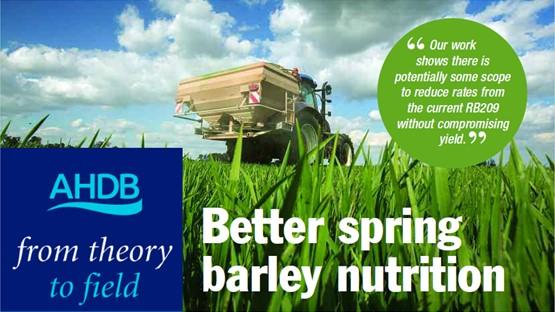From Theory to Field – Better spring barley nutrition

Tailoring nitrogen rates to optimise yield from modern spring barley varieties and hit the quality required by end users can be tricky. A three-year research project offers fresh insights and will help reshape RB209 recommendations, as CPM discovers
Our work shows there is potentially some scope to reduce rates from the current RB209 without compromising yield.
By Paul Spackman
Spring barley has long been central to the rotation on many farms, particularly in Scotland, and in recent years it has also become more popular in less traditional barley-growing areas, not least for its role in blackgrass management strategies.
For many farmers, particularly those new to growing the crop on heavier land, nitrogen management can be quite challenging when trying to balance optimum yields with the specific grain quality requirements of maltsters and other buyers, so having accurate guidance is essential.
A review of the AHDB’s official RB209 Nutrient Management Guide in 2016 highlighted a real need for new data to support nitrogen timing and rate recommendations in modern high-yielding spring barley varieties and prompted the launch of a three-year research project, led by ADAS, which has just concluded.
“A lot of RB209 spring barley nitrogen recommendations were based on data that’s decades old, so we needed new data to help justify the recommendations for modern high-yielding varieties,” explains ADAS crop physiologist Dr Sarah Kendall. “Spring barley yields have increased by an average of 0.4t/ha per decade since the 1980s due to improvements in varieties and crop management.
“Furthermore, we’re increasingly seeing more spring barley grown in new areas and on heavier soil types by growers lacking malting barley experience, so recommendations have to be as accurate as possible to give growers confidence when making management decisions.”
The project began in March 2018, with the aim of updating nitrogen and sulphur fertiliser management guidelines to help growers achieve grain nitrogen targets more reliably and an economically optimal yield from modern spring malting barley varieties. ADAS collaborated with SRUC and the maltsters through MAGB, and the work was funded by AHDB, Limagrain UK, Syngenta UK, Adams & Howling and CF Fertilisers UK.
Trials were conducted at four sites, in Norfolk (sandy loam/ sandy clay loam), Nottinghamshire (loam/ sandy clay loam), North Yorkshire (shallow silty clay loam over chalk) and East Lothian (loam), with a total of 11 nitrogen response and timing experiments conducted across three seasons. Varieties included the modern high-yielders RGT Planet, Laureate, KWS Irina, and LG Diablo, alongside the older “control” variety Concerto.
Across all 11 N-response experiments, the optimum N rate averaged 118kgN/ha, with an average yield of 7.4t/ha and an average grain N of 1.63%.
“The results indicate that whilst yield is affected by variety, with modern varieties yielding more than the older variety Concerto, variety does not significantly affect grain nitrogen percentage,” comments Sarah.
Analysis of the trials and a UK review dataset supports adjusting nitrogen rate for yield by confirming that, in general, every additional tonne of yield requires an extra 22kgN/ha, equivalent to 33kgN/ha of applied fertiliser.
Significantly though, the research shows that on average current RB209 recommendations, which are adjusted up or down from a standard baseline crop yield of 5.5t/ha, overestimate nitrogen requirement by more than 40kg/ha. It’s therefore proposed to change this baseline yield value from 5.5t/ha to 7.5t/ha to minimise variation from the economic optimum nitrogen rate, she explains.
AHDB’s Dr Georgina Key says that following discussion with farmers and industry partners at a technical working group meeting in October, the updated guidance is due to be finalised and published by the end of January 2022 so that the updated RB209 recommendations will be available in time for drilling the 2022 spring barley crop.
“For growers worried about the impact of higher nitrogen fertiliser prices this season, our work shows there is potentially some scope to reduce rates from the current RB209 without compromising yield,” continues Sarah.
However, every crop situation is different. She therefore advises growers to give careful consideration to individual crop requirements and, in particular, the amount of nitrogen available from the soil.
Sarah also points out that RB209 nitrogen recommendations work on an average grain nitrogen of 1.9%, with a recommendation to reduce rates by 30kgN/ha per 0.1% reduction in grain N required to meet end-user specifications. While the latest research confirms this correlation still applies, it also found that 67% of crops in the trial contained grain nitrogen of less than 1.8% so, depending on market requirements, it may not be necessary to reduce rates for grain N in some cases, she explains.
“There’s nothing wrong with setting nitrogen rates for maximum yield but grain nitrogen can be hugely variable. For anyone with yield mapping available on the combine, it may well be worth doing tramline trials to compare your farm standard rate against higher and lower amounts of nitrogen to assess what happens to yield and grain nitrogen. Doing this over a couple of years helps build a good picture of how crops perform in your own farm situation and soil type.”
To minimise the risk of nitrate leaching, it’s recommended that no more than 40kgN/ha should be applied in the seedbed if the crop is sown before March, grown on light-sand soil, or if heavy rain is likely soon after drilling.
“Providing there’s some nitrogen in the seedbed right from the start, growers have reasonable flexibility with the timing of later applications which can be targeted to when conditions are most suitable,” says Sarah.
If low grain nitrogen is a concern, there could be a benefit from delaying the final 30% of nitrogen until GS37, which has been shown to increase grain nitrogen with no adverse effect on yield in some experiments, she notes.
Sulphur recommendations in spring barley were also reviewed in the AHDB trials, with just one trial showing a significant yield response to sulphur.
Sarah says results confirm there’s no need to alter current recommendations, which state that 25–50 kg SO3/ha should be applied in the spring where a risk of sulphur deficiency is identified.
Don’t forget N in the soil
Dr Sajjad Awan of CF Fertilisers welcomes the update to the RB209 guidance and was formerly overseeing the project in his previous role as AHDB resource management scientist.
He believes that understanding how much nitrogen crops can access from the soil is fundamental to optimising rates of applied fertiliser, and there are many ways soil nitrogen supply (SNS) can be assessed, including Soil Mineral Nitrogen (SMN) tests, N-Min tests, or the field assessment method, he says.
“The N-Min test offers the greatest accuracy as it includes nitrogen in the soil at the time of testing (SMN), together with an assessment of how much nitrogen will become additionally available (AAN) to the crop through mineralisation between spring and harvest.
“It can be particularly beneficial on heavier soils, those with a history of organic matter applications, fields coming out of grass leys or where cover crops are grown,” he says.
“Measuring soil nitrogen accurately is the most important thing growers can do, not only for improving the bottom line by reducing input costs, but also to help manage the farm’s carbon footprint effectively. If you don’t know what’s in the soil, there’s no way you can get the nitrogen recommendation correct. If you try and estimate what’s in the soil, there’s a 70% chance you’ll be wrong.”
He highlights one example where soil nitrogen had been estimated at 70kgN/ha, however N-Min testing showed the level to be nearer 130kgN/ha.
“The ideal time for the N-Min test is from January to March, depending on the weather and field conditions, but before the first nitrogen fertiliser application.”
Getting nitrogen into spring barley early is fundamental to producing a successful crop given its comparatively short growing season, and this was clearly highlighted in the AHDB research, highlights Sajjad.
Across 11 nitrogen timing experiments, a significant benefit was found from including nitrogen in the seedbed at drilling and then ensuring all fertiliser was applied by GS30. Not doing so raises the risk of more secondary tillering and higher screenings, he says.
The benefits of seedbed fertiliser are particularly pronounced in dry springs, which seem to be increasingly common, adds Sajjad.
“You’ve got to focus on establishing the crop well, as early as possible, to ensure it can develop strong root systems that are better able to cope with any challenging conditions later in the spring.”
He reminds growers not to focus solely on nitrogen, as many other nutrients affect crop establishment and nitrogen use efficiency. “Phosphorus, for example, is a really important element for helping root development and plant establishment. If the soil index for P is below 2, crops may not establish well, especially if the crop establishment is poor due to the weather conditions.
“Potassium is also very important especially for drought tolerance and crop water balance, as are many micronutrients, so you can’t look at nitrogen in isolation.”
Key points
- Use RB209 as a guide, but tailor nitrogen applications to individual fields, soil type, yield potential and end market requirements
- Measure soil nitrogen supply accurately
- Apply nitrogen early, including 40kgN/ha in the seedbed
- Ensure no deficiencies of other nutrients to maximise nitrogen use efficiency
Managing higher fertiliser prices
The sharp rise in fertiliser prices since the summer will inevitably prompt many growers to re-evaluate their economic optimum for spring fertiliser applications and potentially see rates cut to reduce costs.
Dr Georgina Key says AHDB has put together additional information to help growers decide on the most appropriate nitrogen recommendation at different fertiliser prices. Current RB209 guidance (as outlined in its table 4.22 Effect of economic changes on nitrogen rate – all cereals) only considers fertiliser costs up to £483/t for ammonium nitrate and £644/t for urea, however prices during this autumn have gone well beyond this level.
The information is available to growers via the AHDB website and may also be included in the RB209 update.
The AHDB is also working on a “cost calculator” to help growers decide where fertiliser applications are best used for maximum return and to judge the impact of reducing rates. Contact the AHDB knowledge exchange team for more information.
Spring barley facts
- The UK grows around 700,000-750,00ha of spring barley
- In 2020 the UK area increased 54% to 1.1 million ha due to the wet autumn in 2019 – in England the area increased to 792,000ha, but returned to more normal levels in 2021, at 461,000ha
- Barley accounts for 54% of the total crop area in Scotland
- In 2021 82% of all Scottish barley production was spring sown (249,000ha spring barley, 43,000ha winter barley)
- 2020 was a record year for spring barley yields in Scotland (averaging 6.85t/ha) – first Scottish Government estimates for 2021 are down 0.5t/ha at 6.35t/ha.
Research roundup
From Theory to Field is part of AHDB’s delivery of knowledge exchange on grower-funded research projects. CPM would like to thank AHDB for its support and in providing privileged access to staff and others involved in helping to put these articles together.
AHDB Project No 21140038, ‘Updating nitrogen and sulphur fertiliser recommendations for spring barley’, ran from March 2018 to April 2021 and was led by ADAS in partnership with SRUC, with support from Limagrain UK, Syngenta UK, Adams and Howling and CF Fertilisers at a cost to AHDB of £139,980.
For further information: ahdb.org.uk/rb209

